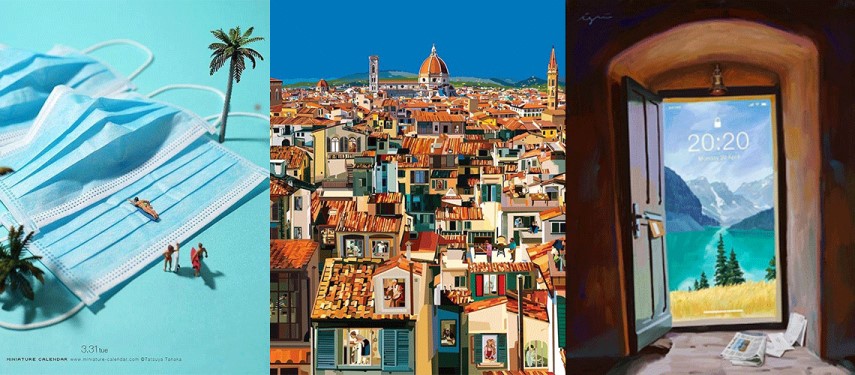Founded by art enthusiasts in Barcelona, the platform claims to be the first digital museum dedicated to Covid-19
Years from now, how will we remember this period in history? One way might be through art. That is the hope of the founders of Covid Art Museum, a digital platform that shares artworks about the coronavirus pandemic on social media.
Created by three art directors in Barcelona – Emma Calvo, Jose Guerrero and Irene Llorca – the digital museum has shared more than 550 works from around the world. Some have been sent to the museum directly by the artists, while others are selected by the founders.
Since its beginnings in mid-March, the Instagram account has gained almost 80,000 followers. “A few days into the quarantine in Spain, we realised people were sharing artwork they created during isolation. Lots of artists, well known and unknown, started pouring out their feelings, perception, and point of view about Covid-19,” Llorca tells The National.
“We could sense a movement here and asked ourselves what would happen with all of this art. We didn’t want these artworks to be forgotten, so we came up with the idea of a digital museum, to make it more accessible for people all over the world.”
In these paintings, photographs, illustrations and digital works, common visual elements surface – masks, gloves, toilet paper, disinfectant and the figure of the virus itself, with its club-shaped spikes.
Beyond that, this new wave of pandemic art echoes the collective experience that has put the world on pause. There is the ennui of quarantine, but also its loneliness; the anxiety around the news; the fear of infection and death; and the struggle of healthcare workers on the front line.
“The artwork displayed show feelings that have sprung from the pandemic: hope, solidarity, a sense of humour, chaos, encouragement … Thanks to artists all over the world who hand in their art, our visitors know they are not alone in this situation,” says Llorca.
The digital museum’s ever-growing audience signals how relevant these themes are to the public. So far, it has received more than 30,000 submissions, mostly from countries such as Spain, Brazil, the US, Argentina, Mexico and Italy. Because of its surge in popularity, the founders brought on board Dilay Yaman, a copywriter in Cologne, to help run the page.
Covid Art Museum is not the only platform collecting coronavirus-related artworks, but it does possess a more curated presentation with wide-ranging pieces that are surreal, humorous, provocative and meditative. “The three of us are passionate about art and we follow many artists and art galleries. This has helped us to find very interesting works,” says Llorca, referring to herself, Calvo and Guerrero.
“A certain quality is also important to us. We don’t look for random selfies or items on the street that are not arranged aesthetically … We want to keep the standards of a museum you’d physically visit,” she adds.
The digital museum has also featured works by Marius Sperlich, Marcio Rodrigues, Banksy, Dave Pollot, Mous Lamrabat, Katherine Lam, CJ Lee and Paola de Grenet, though they were not specifically made for the platform.
A number of selected works stand out, including Johanna Tordjman’s recreation of a photo by Joanna Mangote, showing a woman gazing out of her window. Tordjman turns the Hopper-esque photograph into a painting, and then places a screenshot of Google Street View on to the sky: a glimpse of longing for the outdoors.
Montreal director Catherine White shares works from her initiative #CoronaArtBalance, which asks individuals to create sculptures from household objects and to share images of them online. It is a way of re-looking at the ordinary and sharpening our artistic eye, even while self-isolating at home.
Other creations reflect on the new realities of social distancing, of constant disinfection and of our increased reliance on digital devices during lockdown. In most, there is a sense of yearning for connection or escape.
“We think what people express through their artwork is an important testimony about the pandemic, because it gives you insight into how people lived through it, how they felt and how their reality has changed,” says Llorca.
Through these works, one can see how artists can act as historians. Together, they are visually mapping this moment, with all the confusion and contemplation it carries. When we look back someday, maybe we can make sense of all of it.
www.thenational.ae




